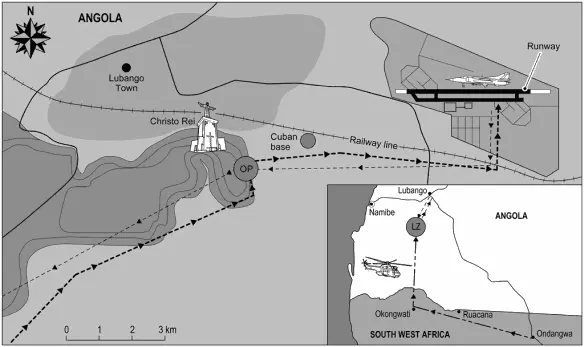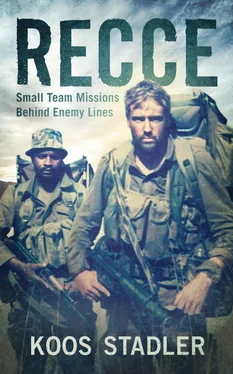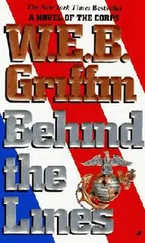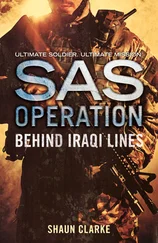9
Three Crosses at Lubango:
Operation Abduct 2, November-December 1987
“Where there is much light, the shadow tends to be deep.”
– Johann Wolfgang von Goethe
WE DEPARTED FOR Ondangwa on a regular scheduled SAAF flight. Although we wore standard-issue bush hats and tried to blend in with the rest of the crowd flying to the war zone, we still stood out like sore thumbs. For one thing, José da Costa’s huge frame was hard to miss, and, for another, the Recces always “hid” their weapons in non-standard (but very obvious!) rifle bags. Even the bags used by Special Forces soldiers were different from the regular army’s balsak . Special Forces soldiers often took the scheduled flights to and from Ondangwa, and so Recces were a fairly regular sight.
Operation Abduct 2

Oom Boet and the Tac HQ team had departed by road to Ondangwa two weeks before the deployment. On our arrival we found the Tac HQ at Fort Rev in the usual predeployment frenzy. The most important task that remained for the team was to brief the Tac HQ, as well as the pilots and the “back-up” team on the emergency procedures and E&E plan. Before this could be done, the team had to work through the emergency procedures, escape routes and rendezvous (RV) points to ensure that each one understood and memorised every single detail and, more importantly, that each procedure and each action had the same meaning for all three of us. The E&E plan the Tac HQ would implement if anything went wrong was then meticulously drawn on a map overlay.
We had decided on a landing zone (LZ) 60 km south of the Lubango airfield. The team would deploy by rappelling from the helicopters onto the highest mountain ridges, where we would establish a cache and observe the area for two days. Fighter jets would act as an escort for the helicopters. Because of the distances involved and the dangers of flying into an area where the enemy had air superiority, the fighters were also assigned the job of telstar should there be a communication breakdown or any other emergency. The back-up team, made up of Special Forces soldiers from 51 Commando, would deploy to the last known location of the team should the E&E plan be activated.
We would take the normal large Small Team pack for the infiltration, and switch to the pack designed for the explosives on the night of the penetration. During the final inspection our equipment was once again thoroughly checked and scrutinised for non-traceability. Not one single piece of equipment could be linked to South Africa. Then each operator handed his Captured Info document to Oom Boet for safekeeping, the contents securely committed to memory.
Our choice of weapons was, as always, meticulously planned: I would carry my trusted Hungarian AMD and silenced pistol; Diedies had a silenced BXP and a pistol (without silencer); and José da Costa took a normal AKM (the modernised version of the AK-47) and a Russian-origin Tokarev pistol. Since I was doing the navigation on the route in, I would be armed with a non-silenced weapon – to work in our favour during an initial engagement. We knew from experience that silenced weapons did not hold the enemy’s heads down, presumably because they did not realise they were being shot at. Likewise Da Costa would have a non-silenced assault rifle for support fire. During the penetration, Diedies would lead with the silenced BXP, ready for initial contact. If I had to do a stalk on an aircraft, I would approach with the silenced pistol and keep the AMD on my back for firepower in case we needed to fight our way out.
Our lunch before the deployment was a lavish spread, and a cheerful atmosphere reigned. Boet Swart proposed a toast to the “conquering” of Lubango. He joked about the packs being bigger and heavier than the operators themselves.
“Small team, big pack, small brain…” he said, as so many times before. “I’ll never understand the small minds of the men with the big packs. They could have all this wonderful food, a warm bed to sleep in, pretty girls, and yet here they are off into the bush again…”
The huge packs were loaded onto the choppers on the hardstand before start-up. Both helicopters had been prepared for rappelling, and the A-frames had been fitted in a closed hangar the night before. The system used for rappelling from the Puma at the time was a frame that fitted into the helicopter, with extension arms that contained the anchor points for the ropes. The frames were intended to prevent excessive external force on the superstructure of the aircraft. The plan was for the operators to rappel down first, after which the heavy packs and cache equipment would be lowered by a pulley system.
At 14:00 the Pumas, each with two additional ferry tanks mounted on the inside, had taxied out and waited for us in front of Fort Rev. We flew to Opuwa in the Kaokoland, where the helicopters had to refuel. I tried to sleep on the way, but was too excited.
This deployment was the one we had been living for; it was a textbook Small Team operation. To me it felt as though we had spent a lifetime preparing for Lubango. The very name of the place had a mysterious ring to it. Strangely, a deep and profound calmness had come over me, and a determination I had not quite experienced before. I visualised how we would fly back in the same helicopter a month later – having achieved success. I had a distinct vision of how we would approach the target and work our way from aircraft to aircraft.
This new feeling did not at all mean that I was not afraid. I did not have a death wish, nor was I under some wild delusion that we would rush in and show everyone how it was done. After weeks of meticulous planning and preparation, the sessions with Johnny and the few days I had spent alone along the Orange River, I felt content and at ease with what lay ahead.
While we waited for last light, Oom Sarel shared the customary communion with us under a cluster of trees. His message took me back a few years, to the moment before my very first Special Forces deployment with 53 Commando at Nkongo, when he had built mountains in the sand to explain the meaning of Psalm 125:2: “As the mountains surround Jerusalem, so the Lord surrounds His people now and forever.”
He made this verse applicable to Lubango, and reminded us that, as the mountains surround the town to the south and west, the Lord is always there, with the only difference being that He completely surrounds us. Oom Sarel’s message was simple and to the point and added to my sense of calmness and determination. Never before had the wine and bread had such a tangible meaning for me as on the eve of our deployment to Lubango, when I shared it with my comrades and Oom Boet.
After the short service I asked Diedies how he felt, knowing full well that his priorities had shifted now that he was a married man. But if I had forgotten the iron will and unique fibre of the man, his big smile and quick answer reminded me promptly. “Camels don’t cry, Kosie,” he said, referring to the motto displayed on the 52 Commando logo. I knew Da Costa was okay; he was as solid as the very mountains around Lubango.
Just before last light we received a message that the jets were airborne for their top-cover job. We flew straight from Opuwa to the border and crossed the Cunene River in the area west of Swartbooisdrift, then nap-of-the-earth towards the LZ, following the valleys and depressions of the rugged southwestern Angolan countryside. Diedies, Da Costa and I were in the first chopper, along with the two dispatchers. The packs and the bulky cache equipment were in the second one, with two dispatchers ready to let the equipment down by pulley.
Читать дальше













